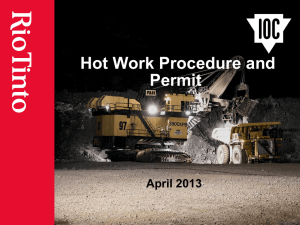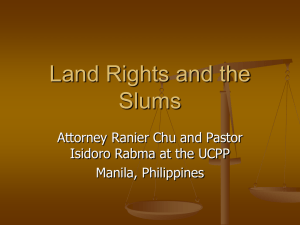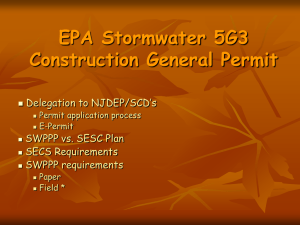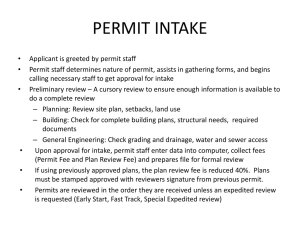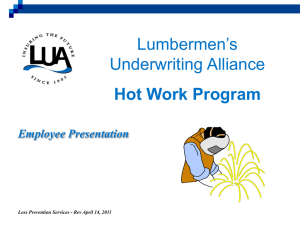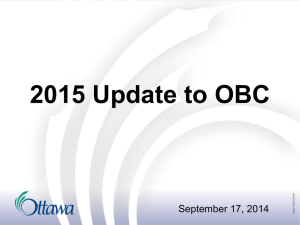Issuance of the exploitation permit
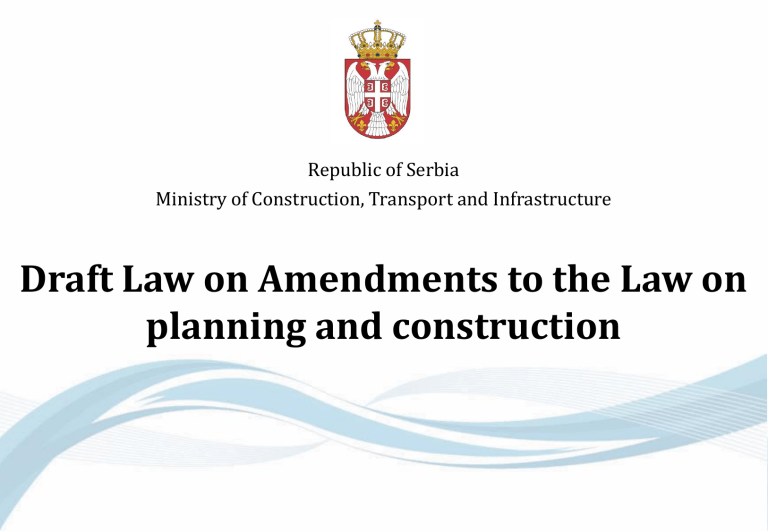
Republic of Serbia
Ministry of Construction, Transport and Infrastructure
Draft Law on Amendments to the Law on planning and construction
Why a reform?
Serbia’s ranking on Doing Business list of World Bank
Key reform challenges
1. Unsolved property relations , especially property-legal relations on construction land
2. Insufficient coverage of the territory of The Republic of Serbia with planning documents as well as their quality
3. Fragmented authorities and responsibilities: state bodies, local selfgovernment, public companies, institutes, directorates etc.
4. Lack of evaluation of work results of participants in a procedure
5. Disproportionate administrative and other costs in the process of realization of building rights.
6. The length of waiting time to obtain a construction permit
Reform challenges
On the final list of Doing Business report for 2015, Serbia takes 186 th out of 189 places as regards efficacy of obtaining a construction permit.
Greece (88th place)
Bulgaria(101 st place)
Hungary(103rd place)
Slovakia(110th place)
Regional average (Europe and Central Asia )
(118th place)
Romania(140th place)
Croatia(178th place)
Serbia(186th place)
Ranking is based on the period of time needed for an entrepreneur to build a warehouse
From an investment decision to the registration of land title
1. The procedure of obtaining the necessary documentation for construction is conducted within a unified procedure, at one place , from issuance of site conditions to the issuance of the exploitation permit.
2. The investor submits only the documents that the competent authority cannot obtain ex officio.
3. All rights are obtained on the cadastral plot that meets all the requirements for the building lot.
4. Each person that has corresponding rights on a piece of land or a facility has the right to buil.
5. Sponsor- a person who beside the investor has the right in the process, but does not acquire the right to the property - neither the facility nor the land.
From an investment decision to the registration of land title
1. Preliminary design preparation
2. Issuance of site conditions (5+15+5);
3. Preparation of project for the issuance of construction permit ;
4. Issuance of construction permit (5);
5. Preparation of the construction project
6. Call for papers for the submission of works
7. Construction works execution
8. Technical check-up of the facility
9. Preparation of the project for additional facilities (only if there were changes during the construction)
10. Issuance of the exploitation permit (5);
11. Registration of land
Site conditions
1. Contain data on possibilities and limitations of building on a cadastral plot, e.g. all conditions necessary for the preparation of project for the building permits.
2. Issued by The Ministry, e.g competent authority of the autonomous national or local self-government bodies.
3. Investor submits a preliminary project of the future project ;
4. The issuance deadline is 25 days since the day of the submitted permit.
(5+15+5);
5. A complaint about the issued site conditions can be filed to the local council, e.g city council or the government.
6. If the plan of Detailed Regulation has not been adopted, site conditions are issued based on the official act that prescribes general rules of planning and construction or based on the existing document on planning if it contains the regulation line.
Construction permit
1. Public act issued by the competent authority within 5 days of submitting a valid application.
2. Construction permit is issued to the investor that submits project excerpt, the project documentation for construction permit, that has the corresponding right to the land or facility, that has regulated his /her relations with the local self-government in terms of land development fee and has paid for the administrative taxes;
3. Competent authority only verifies that the formal conditions for the construction have been met;
4. The investor is not obliged to pay for the land development fee until the performance of works;
5. Upon the issuance of the construction permit, the investor can start with the preliminary works and preparation of the main desig.
Call for papers
1. Upon the preparation of construction project, 8 days before the beginning of performance of works, the investor submits the call for papers to the authority that has issued the construction permit.
2. Along the call for papers, a proof that the investor has paid for the land development fee and regulated his/her relations with the corresponding local self-government body must be submitted.
3. Call for papers contains the start and end date of construction works.
4. Deadlines for the completion of works are valid from the day of submission of call of papers.
Exploitation permit
1.
2.
3.
4.
The investor provides the the technical inspection of the facility
Technical inspection of the facility is done by a board or a business association appointed by the investor
With the application for the issuance of the exploitation permit, the board decision on the inspection by which it is granted that the facility is eligible to use is submitted with the proposal for the exploitation permit issuance, final design, and geodetic survey for the facility and the underground installations and energy permit if needed .
Exploitation permit is issued within 5 days and is delivered to the investor and the corresponding building inspectorate.
Registration of land
1. Application for the registration of land is submitted to the real estate cadastre on the territory of the local self-government where the facility is located.
2. Within 5 days of the validity of the issued exploitation permit, the competent authority submits the permit and geodetic survey for the facility and its underground installations ex officio to the body responsible for the state survey and cadastre.
3. The body responsible for the state survey and cadastre issues a decision on the facility number and registration of land e.g registration of particular parts of the facility and informs the investor and the competent authority 7 days from the issuance of the exploitation permit and registers the land into the utility cadastre within 30 days.
Spatial and urban planning
1.
Concept plan abolished;
2.
Early public access conducted upon the decision on the plan preparation;
3.
New urban - technical document – geodetic survey of border corrections of the neighboring plots and merging of two neighboring plots belonging to the same owner.
4. Director city planner ;
5. The agreement of the ministry is not obtained for CUP ( only for cities ) and PGR of a residential are.
6. DRP and urban projects can also be prepared when not specified by the area-wide plan and can be financed by individuals or legal entities.
Building land
1. Specific provisions on land exploitation, lease, alienation, acquisition and conveyance of building land as well as the thorough procedure of conversion of agricultural and forest land into construction land;
2.
Lacking infrastructure can be built through investors’ funding, e.g. cofunding , e.g investors’ and local self-government co-funding – the contribution is reduced by the assets invested into the co-funding;
3.
Compensation fee for land restructuring changed into contribution;
4.
Maximum contribution is determined (tax base is the average price of a square meter of an apartment – new building in local self-government, and the highest rate is 15%)
5.
Local self-government determines the coefficients according to the facility zone and purpose, so that the range is not over 1:6.
Building land
6.
Contribution is not paid for the explicitly stated facilities, e.g works: infrastructural, production, stock, underground floors etc.;
7.
Contribution is determined by an offcial decision and makes up for an integral part of the construction permit;
8.
Settlement of contribution is not a prerequisite for the issuance of the construction permit, and is due before the notice of commencement of works;
9.
Established principle of real estate unity.
Building land concession is converted into the right to property, no fee needed (general principle)
1. Right to property is granted by law, ex lege, on the day the law takes effect, and the registration of land title is administered by the competent authority
(RGA) ex officio.
2. The right is erga omnes, except for persons who can achieve this right with a fee (Article 102, Paragraph 9);
3. Terms and conditions of the conversion of building land concession into the right to property for persons stated in Articles 103-106a of the current law will be arranged by a new law.
4. Exceptionally, the right to building land for these persons is building land concession on the land that has been registered into property records, until a separate directive that will define the right to property and the manner to acquire the right to property on the building land for these persons is adopted.
Some expected results
- Greater offer of legal building land locations.
- Citizens’ participation in the early phase of preparation of planning documents
- more quality plans and elimination of potential conflicts concerning suggested planning solutions
- Possibility of financing the preparation of planning documents by interested persons – certain locations will fit the urban planning framework faster;
- Shorter time of issuing the corresponding documentation;
- Elimination of parallel actions from other laws;
- ”One desk for the investors” – a unified procedure;
- Enhanced responsibility of all participants in the process;
- More efficient and more responsible public administration - better and faster services provided for the investors.
Some expected results
The World Bank estimates that for an ordinary warehouse in Serbia it takes around 219 days to get the exploitation permit and 45 more days to register the facility.
Independent consultants estimate that according to the model we suggest the exploitation permit will be issued within the period of 54 days – it will take 165 days less than it is now.
In 2013 the total of 7 447 construction permits have been issued.
When that number is subtracted with the 165 days we saved per project, we come to 1.2 million days saved in the process of issuing the exploitation permit.
Possible economic effects
1. Construction industry in Serbia does not meet its potentials and is 4.2% GDP
(average for OECD countries is 6.1%);
2. Serbia’s aim is for it to be 7% by 2017
3. Construction is a sector with an extremely high ‘multiplicative’ effect;
4. The experience of other countries: the reforms in the construction industry can provide the increase of jobs and the total economic activity;
5. Simplified realization of infrastructural projects.
Republic of Serbia
Ministry of Construction, Transport and Infrastructure


